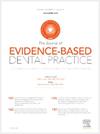THE ASSOCIATION BETWEEN PERIODONTAL DISEASE AND STROKE RISK: A SYSTEMATIC REVIEW AND META-ANALYSIS
IF 4
4区 医学
Q1 DENTISTRY, ORAL SURGERY & MEDICINE
引用次数: 0
Abstract
Objective
The prevention of stroke is of paramount importance, and periodontal disease may play an important role in this process. This study aims to evaluate the association between periodontal disease and stroke risk.
Methods
The study was conducted in accordance with the PRISMA 2020 guidelines. We comprehensively searched PubMed, EMBASE, Scopus, Web of Science, and the Cochrane Library from inception to December 2024 to identify relevant studies. Quality assessment was conducted using both the original and modified versions of the Newcastle-Ottawa Scale as appropriate. Data such as sample size, region, age, and gender of participants were extracted. Odds ratios (OR) were pooled using a random-effects model, and 95% confidence intervals (CI) were calculated. Sensitivity analysis, cumulative meta-analysis, multiple subgroup analyses, and publication bias assessments were also performed to assess the stability of the results.
Results
A total of 36 studies, including 7,665,431 participants, were included in the meta-analysis, consisting of 20 cohort studies, 9 case-control studies, and 7 cross-sectional studies. The findings indicate that individuals with periodontal disease have a significantly higher risk of stroke compared to the healthy population (OR: 1.724, 95% CI: 1.481-2.008). This conclusion holds across different regions, genders, and age groups. Periodontitis patients exhibited a higher risk of stroke compared to those with gingivitis (OR: 2.008 vs 1.673), and the risk of ischemic stroke was higher in individuals with periodontal disease than the risk of hemorrhagic stroke (OR: 1.846 vs 1.476). Sensitivity analysis, cumulative meta-analysis, and publication bias detection further confirm that the conclusion remains stable (Egger’s tests, P = .280 and Begg’s tests P = .703), even after imputing missing studies using the trim-and-fill method. Meta-regression analysis suggested that age may contribute to the heterogeneity observed in the studies.
Conclusions
Periodontal disease has been identified as an independent risk factor for stroke. Regular and effective dental biofilm control may help reduce the risk of stroke in patients with periodontal disease. The underlying mechanisms by which periodontal disease increases stroke risk warrant further investigation.
牙周病和中风风险之间的关系:一项系统回顾和荟萃分析
目的预防脑卒中至关重要,牙周病可能在卒中预防中起重要作用。本研究旨在评估牙周病与中风风险之间的关系。方法本研究按照PRISMA 2020指南进行。我们全面检索了PubMed、EMBASE、Scopus、Web of Science和Cochrane Library从成立到2024年12月的相关研究。根据情况,使用纽卡斯尔-渥太华量表的原始版本和修改版本进行质量评估。提取了参与者的样本量、地区、年龄和性别等数据。使用随机效应模型合并优势比(OR),并计算95%置信区间(CI)。还进行敏感性分析、累积荟萃分析、多亚组分析和发表偏倚评估来评估结果的稳定性。结果meta分析共纳入36项研究,包括20项队列研究、9项病例对照研究和7项横断面研究,共计7665431名受试者。研究结果表明,与健康人群相比,牙周病患者中风的风险明显更高(OR: 1.724, 95% CI: 1.481-2.008)。这一结论适用于不同的地区、性别和年龄组。与牙龈炎患者相比,牙周炎患者卒中的风险更高(OR: 2.008 vs 1.673),牙周病患者缺血性卒中的风险高于出血性卒中的风险(OR: 1.846 vs 1.476)。敏感性分析、累积荟萃分析和发表偏倚检测进一步证实结论保持稳定(Egger检验,P = )。280和Begg的检验P = .703),即使在使用修剪填充方法输入缺失的研究之后。荟萃回归分析表明,年龄可能导致研究中观察到的异质性。结论牙周病是脑卒中的独立危险因素。定期和有效的牙齿生物膜控制可能有助于降低牙周病患者中风的风险。牙周病增加中风风险的潜在机制值得进一步研究。
本文章由计算机程序翻译,如有差异,请以英文原文为准。
求助全文
约1分钟内获得全文
求助全文
来源期刊

Journal of Evidence-Based Dental Practice
DENTISTRY, ORAL SURGERY & MEDICINE-
CiteScore
6.00
自引率
16.70%
发文量
105
审稿时长
28 days
期刊介绍:
The Journal of Evidence-Based Dental Practice presents timely original articles, as well as reviews of articles on the results and outcomes of clinical procedures and treatment. The Journal advocates the use or rejection of a procedure based on solid, clinical evidence found in literature. The Journal''s dynamic operating principles are explicitness in process and objectives, publication of the highest-quality reviews and original articles, and an emphasis on objectivity.
 求助内容:
求助内容: 应助结果提醒方式:
应助结果提醒方式:


